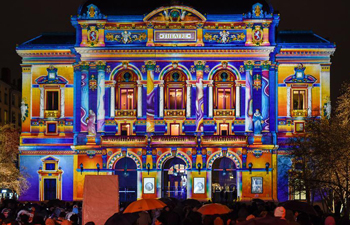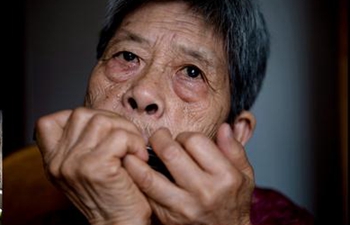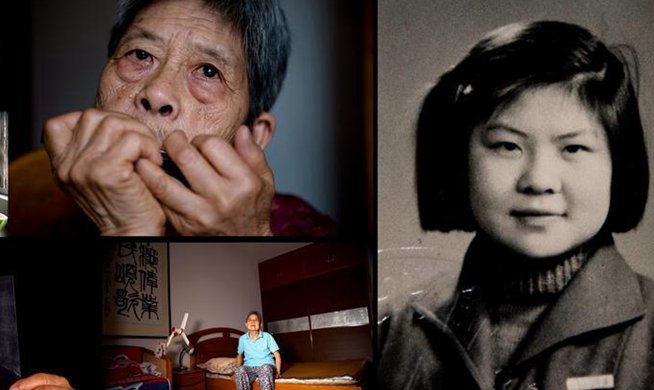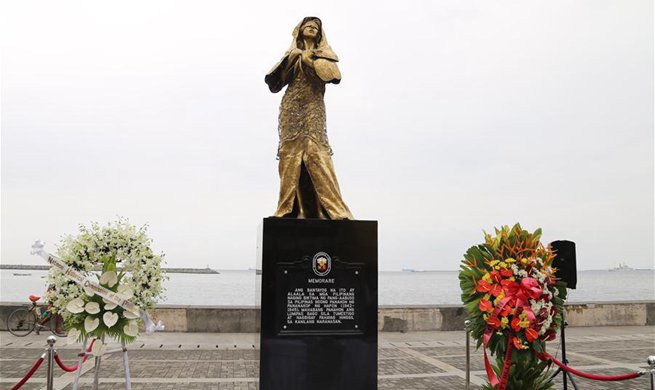PARIS, Dec. 8 (Xinhua) -- With his latest painting, "Cry of pain in Nanjing," French artist Christian Poirot is hoping to remind people of the sex slave victims of the Japanese military.
The painting is to join another three of his paintings on the same subject to be presented in China for the Nanjing Massacre Commemoration Day that falls on Dec. 13.
Poirot said he would like to use his canvas to contribute to the remembrance of "comfort women," a euphemism for victims of the sex slavery by and for the Imperial Japanese military during during the Second World War.
"I created this painting to draw the attention of the international community to the actions of certain countries who try by all means possible to erase the somber pages of their history. The work of remembrance on the subject of 'comfort women' has only just begun," Poirot told Xinhua during a recent interview given at his home in Mulhouse, eastern France.
"I don't like this euphemism 'comfort women' used to designate the victims, very often underage, sometimes very young, of the mass sexual slavery system organized throughout Asia by and for the Imperial Japanese army and navy, in particular during the Second World War," the artist said.
The term was created by Japanese military authorities during the war. These women were swept up by the Imperial Japanese army to serve as sex slaves as part of a political system justified by the Japanese authorities, reminded the French painter.
Even if the exact number of victims is still difficult to evaluate due to the absence of precise records, it is known that several hundred thousand women from Asia, of which a great number were Chinese, were forced to become "comfort women" during the war. Only 14 of them are still alive in China, after the death of a 90-year-old woman in August 2017.
"It took dozens of years for languages to liberate themselves on the subject of the horror these women faced," said Poirot, who had himself discovered this tragic episode of history during one of his numerous visits to China. "The surviving comfort women in China are particularly disappointed by the postponement of the enrollment of documents concerning them in the UNESCO Memory of the World Register" in October, he said.
In June 2017, thanks to his friend, the curator of the Nanjing Memorial, Poirot could paint in the museum dedicated to comfort women which was created on the same site as a Japanese brothel. "I immersed myself in this place which runs chills down your spine, where we have the impression that the walls weep, as if the tears of the women which were trapped there are still falling, where I was assailed by violent emotions," he said.
"This painting, due to its tragic subject, was difficult to complete," the artist confessed. "I was plunged in a storm of emotions, from disgust to hate, rage, shame as well...faced with this crime against humanity," he said, while presenting the painting during the interview.
The painting is made of three sections which tell the different scenes of the history of comfort women. A first section depicts soldiers taking young girls from their families. The second section depicts "a voyage toward horror," with a pile of corpses, hanged women, and other violent scenes. The third section shows the daily violence faced by the comfort women.
Poirot paints his characters in a non-realist style, but with expression. The forms are fragmented, sometimes appearing as images within images.
"This painting is also dedicated to all the victims of sexual services of all the wars. We know that rape is very often used as a weapon of war," he said. "And in the moment when the whole world is caught up in the scandals of sexual predators in the aftermath of the Weinstein affair, I think that it's urgent to defend the cause of women as a whole," he concluded.
For the 70th anniversary of the end of the Second World War, Poirot had made a poignant but massive painting on the Nanjing Massacre called "Deliverance" which he presented as a gift to the Memorial Hall in Nanjing. For more than six weeks, from Dec. 13, 1937 to January 1938, more than 300,000 Chinese were murdered by Japanese invaders.
With his large palette, the artist also likes to work on less somber and painful subjects. "Through landscapes and scenes of daily urban life, I want to show the modernity of a China which is changing, to escape the cliches which Europeans often have. During my trips through China, I draw my inspiration. I would like to paint a series on all the provinces of the country," he said.
Formerly a chemical engineer, Poirot began to paint at the age of 26. He studied locally, then in Paris, earning distinctions and holding numerous exhibitions in the galleries of several countries.

















